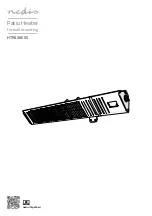
E
ng
lish
6
LOCATION
Although this heater incorporates a “tip over” switch, the heater and LP-Gas
supply cylinder must be located on a hard, flat, level surface to minimize the
risk of accidental tipping. The LP Gas supply cylinder should be adequately
restrained to prevent accidental tipping.
DO NOT OPERATE this heater with
the supply cylinder in any other than the upright position.
This appliance must be placed only in locations where the potential for physical
damage to the appliance (i.e., due to physical contact) is reduced to a minimum.
Precautions must be taken to protect the appliance from physical damage.
This appliance produces radiant heat. Therefore, it must be located at least six
feet away from any LP-Gas container and must not be directed toward any LP-
Gas container within 20 feet.
The heater must be located in a location such that it will not be exposed directly
to water spray, rain, and/or dripping water.
Use of this heater in a draft/windy area may decrease its efficiency. If possible,
operate the unit in a draft free area or turn the face of the heater away from the
draft.
The intended use of for this heater is the temporary heating of buildings or
structures under construction, alteration or repair.
PIPING
For Model DXH45LP
(for use with LP-Gas)
This model may be connected to a self-contained LP-Gas supply system using
the hose and regulator assembly supplied with the appliance, OR, it may be
connected to a permanently installed LP-Gas supply system.
If connected to a self-contained LP-Gas supply system, the hose assembly must
be inspected prior to each use of the heater. If it is evident that there is excessive
abrasion or wear, or the hose is cut, it must be replaced prior to the heater being
put into operation.
If connected to a self-contained LP-Gas supply system, the cylinder must have no
less than a minimum capacity of 20 pounds and no more than a maximum capacity
of 100 pounds of LP-Gas. DO NOT connect this appliance to a cylinder having less
than a nominal 20 pound capacity of LP-Gas. DO NOT connect this appliance to
more than one (1) 100 pound cylinder.
The connection of Model DXH45LP to an LP-Gas cylinder must be made in a well
ventilated area using the regulator and hose assembly supplied with the appliance.
DO NOT attempt to adjust this regulator. It has been preset at the factory to provide
safe and proper operation of the appliance. Use a 7/8” open end wrench to connect
the POL fitting (supplied with the LP regulator) to the LP-Gas cylinder. Turn the POL
nut in a counter-clockwise direction (left hand thread) until tight. DO NOT use pipe
compound on POL threads.
The heater must be located at least six feet away from any LP-Gas cylinder and must
not be directed toward any LP-Gas cylinder within 20 feet. If more than one heater is
used, they and the supply cylinders must be separated by at least 20 feet.
The gas supply must be turned off at the LP-Gas supply cylinder when the heater is
not in use.
When the heater is to be stored indoors, the connection between the LP-Gas supply
cylinder and the heater must be disconnected and the cylinder removed from the
heater and stored in accordance with Chapter 5 of the Standard for the Storage and
Handling of Liquefied Petroleum Gases, ANSI/NF-PA 58 (U.S.), OR CAN/CGA B149.2
(Canada).
If connected to a permanently installed LP Gas supply system, the system requires
the use of a two-stage gas regulator assembly which is normally provided by your
LP-Gas dealer as part of the LP-Gas supply system. Consult with your local LP-Gas
dealer for details concerning proper equipment and installation.
Piping must be clean and free from scale or burr.
Before attempting to ignite the appliance, all gas fittings and connections must be
thoroughly checked for gas leaks. Apply a small amount of a mild soap and water
solution to all fittings and connections and observe for escaping bubbles. If any leaks
are detected, shut off the gas supply to the appliance immediately. Wait a minimum of
five minutes, repair the leak(s) and retest for leakage. Dry all fittings and connections
after leak testing.
WARNING
Never use a flame for gas leak testing.
WARNING







































